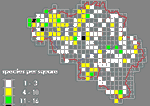 Dr. Baert (Royal Institute of Natural Sciences) kindly put the relevant collections at
my disposal. Although Opiliones were never the object of a sampling session,
the bottles were rich enough to keep me happy for several years on row.
I added some material from my own entomological studies and from the former
Laboratory of Oecology (State University Ghent).
Dr. Baert (Royal Institute of Natural Sciences) kindly put the relevant collections at
my disposal. Although Opiliones were never the object of a sampling session,
the bottles were rich enough to keep me happy for several years on row.
I added some material from my own entomological studies and from the former
Laboratory of Oecology (State University Ghent).
 When finally the number of Opiliones minded
people doubled with W. Slosse, I knew that distribution maps with not too many blancs where within reach. His umbrella sampling-method is very succesful,
as proved by the explosion of recent observations in the western part of the country. When finally the number of Opiliones minded
people doubled with W. Slosse, I knew that distribution maps with not too many blancs where within reach. His umbrella sampling-method is very succesful,
as proved by the explosion of recent observations in the western part of the country.
|

